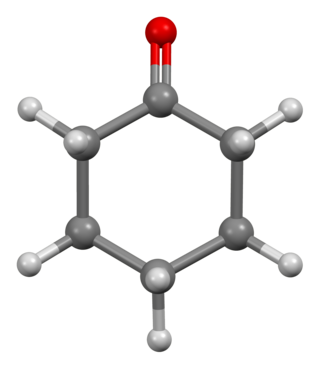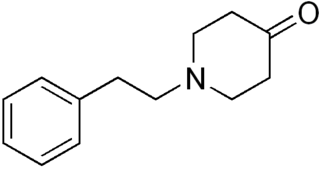Related Research Articles

The Controlled Substances Act (CSA) is the statute establishing federal U.S. drug policy under which the manufacture, importation, possession, use, and distribution of certain substances is regulated. It was passed by the 91st United States Congress as Title II of the Comprehensive Drug Abuse Prevention and Control Act of 1970 and signed into law by President Richard Nixon. The Act also served as the national implementing legislation for the Single Convention on Narcotic Drugs.

Butanone, also known as methyl ethyl ketone (MEK) or ethyl methyl ketone, is an organic compound with the formula CH3C(O)CH2CH3. This colorless liquid ketone has a sharp, sweet odor reminiscent of acetone. It is produced industrially on a large scale, but occurs in nature only in trace amounts. It is partially soluble in water, and is commonly used as an industrial solvent. It is an isomer of another solvent, tetrahydrofuran.
Clandestine chemistry is chemistry carried out in secret, and particularly in illegal drug laboratories. Larger labs are usually run by gangs or organized crime intending to produce for distribution on the black market. Smaller labs can be run by individual chemists working clandestinely in order to synthesize smaller amounts of controlled substances or simply out of a hobbyist interest in chemistry, often because of the difficulty in ascertaining the purity of other, illegally synthesized drugs obtained on the black market. The term clandestine lab is generally used in any situation involving the production of illicit compounds, regardless of whether the facilities being used qualify as a true laboratory.

Acetic anhydride, or ethanoic anhydride, is the chemical compound with the formula (CH3CO)2O. Commonly abbreviated Ac2O, it is the simplest isolable anhydride of a carboxylic acid and is widely used as a reagent in organic synthesis. It is a colorless liquid that smells strongly of acetic acid, which is formed by its reaction with moisture in the air.

The United Nations Convention Against Illicit Traffic in Narcotic Drugs and Psychotropic Substances of 1988 is one of three major drug control treaties currently in force. It provides additional legal mechanisms for enforcing the 1961 Single Convention on Narcotic Drugs and the 1971 Convention on Psychotropic Substances. The Convention entered into force on November 11, 1990. As of June 2020, there are 191 Parties to the Convention. These include 186 out of 193 United Nations member states and the Holy See, the European Union, the Cook Islands, Niue, and the State of Palestine.

The Misuse of Drugs Act 1973 is a drug control law in Singapore classifying substances into three categories, Classes A, B, and C. Section 44 provides that "The Minister may, by an order published in the Gazette" add, remove, or transfer drugs among the classes. The statute's penal provisions are severe by most nations' standards, providing for long terms of imprisonment, caning, and capital punishment. The law creates a presumption of trafficking for certain threshold amounts, e.g. 30 grams of cannabis. It also creates a presumption that a person possesses drugs if he possesses the keys to a premises containing the drugs, and that "Any person found in or escaping from any place or premises which is proved or presumed to be used for the purpose of smoking or administering a controlled drug shall, until the contrary is proved, be presumed to have been smoking or administering a controlled drug in that place or premises." Thus, one runs the risk of arrest for drug use by simply being in the company of drug users. The law also allows officers to search premises and individuals, without a search warrant, if he "reasonably suspects that there is to be found a controlled drug or article liable to seizure". Moreover, Section 31 allows officers to demand urinalysis of suspected drug offenders while section 8A prohibits any citizen or permanent resident of Singapore to use any prohibited drug outside of the country, and if found guilty to be punished as if they committed that act within the country.

Cyclohexanone is the organic compound with the formula (CH2)5CO. The molecule consists of six-carbon cyclic molecule with a ketone functional group. This colorless oily liquid has a sweet odor reminiscent of benzaldehyde. Over time, samples of cyclohexanone assume a pale yellow color. Cyclohexanone is slightly soluble in water and miscible with common organic solvents. Billions of kilograms are produced annually, mainly as a precursor to nylon.

3,4-Methylenedioxyphenylpropan-2-one or piperonyl methyl ketone is a chemical compound consisting of a phenylacetone moiety substituted with a methylenedioxy functional group. It is commonly synthesized from either safrole or its isomer isosafrole via oxidation using the Wacker oxidation or peroxyacid oxidation methods. MDP2P is unstable at room temperature and must be kept in the freezer in order to be preserved properly.

The Chemical Diversion and Trafficking Act of 1988 was an amendment to the Controlled Substances Act to regulate precursor chemicals, essential chemicals, tableting machines, and encapsulating machines by imposing record keeping and import/export reporting requirements on transactions involving these materials. Prior to these restrictions being put in place, the U.S. had been the primary source of chemicals used in South American cocaine manufacture. According to the DEA, the Act sharply reduced these precursor exports and cocaine manufacturers responded by purchasing from chemical suppliers outside the U.S. The U.S. in turn successfully lobbied for inclusion of chemical controls in the 1988 United Nations Convention Against Illicit Traffic in Narcotic Drugs and Psychotropic Substances, which included two Tables of controlled precursors.

Phenylacetone, also known as phenyl-2-propanone, is an organic compound with the chemical formula C6H5CH2COCH3. It is a colorless oil that is soluble in organic solvents. It is a mono-substituted benzene derivative, consisting of an acetone attached to a phenyl group. As such, its systematic IUPAC name is 1-phenyl-2-propanone.

Phenylacetic acid, also known by various synonyms, is an organic compound containing a phenyl functional group and a carboxylic acid functional group. It is a white solid with a strong honey-like odor. Endogenously, it is a catabolite of phenylalanine. As a commercial chemical, because it can be used in the illicit production of phenylacetone, it is subject to controls in countries including the United States and China.
Benzyl chloride, or α-chlorotoluene, is an organic compound with the formula C6H5CH2Cl. This colorless liquid is a reactive organochlorine compound that is a widely used chemical building block.
The Étard reaction is a chemical reaction that involves the direct oxidation of an aromatic or heterocyclic bound methyl group to an aldehyde using chromyl chloride. For example, toluene can be oxidized to benzaldehyde.

N-Phenethyl-4-piperidinone (NPP) is a derivative of 4-piperidinone with the molecular formula C13H17NO. It is used as an intermediate in the manufacture of chemicals and pharmaceutical drugs such as fentanyl.

Ergocristine is an ergopeptine and one of the ergot alkaloids. As of February 24, 2010 ergocristine has been federally regulated. Because of the existing Controlled Substance Act regulatory controls on the LSD precursors lysergic acid, lysergic acid amide, ergotamine, and ergonovine, clandestine laboratory operators have sought uncontrolled sources of precursor material for the production of LSD. This has led to the illicit utilization of the precursor chemical ergocristine as a direct substitute for ergotamine and ergonovine for the illicit production of LSD. In fact, the largest clandestine LSD laboratory ever, William Leonard Pickard and Clyde Apperson, that was seized by the Drug Enforcement Administration (DEA) utilized ergocristine as the LSD precursor according to court documents.

The Decree-Law 15/93 of January 22 is a Portuguese drug control law implementing the 1988 United Nations Convention Against Illicit Traffic in Narcotic Drugs and Psychotropic Substances.

The Comprehensive Methamphetamine Control Act of 1996 is a bill enacted into law by the 104th Congress of the United States. It mandated registration of persons trading in list I chemicals from the DEA list of chemicals. A fee for such registration was initially $595 but later reduced to $116. It is regarded as one of the major drug laws in the United States.
European law on illicit drug precursors:
Drug precursors, also referred to as precursor chemicals or simply precursors, are substances used to manufacture illicit drugs. Most precursors also have legitimate commercial uses and are legally used in a wide variety of industrial processes and consumer products, such as medicines, flavourings, and fragrances.
References
- ↑ 21 U.S.C. § 802, paragraphs 34 (list I) and 35 (list II)
- ↑ DEA (2013). "Chemical Handler's Manual" (PDF). usdoj.gov. Archived from the original (PDF) on 2017-04-27. Retrieved 2017-05-05.
- ↑ "eCFR :: 21 CFR 1310.02 -- Substances covered". 2022-05-11. Archived from the original on 11 May 2022. Retrieved 2022-05-12.
- ↑ "Title 21 CFR - PART 1310 - Section 1310.02 Substances covered". Archived from the original on December 15, 2014. Retrieved August 28, 2014.
- 1 2 "Special Surveillance List of Chemicals, Products, Materials and Equipment Used in the Clandestine Production of Controlled Substances or Listed Chemicals". Archived from the original on April 20, 2011. Retrieved May 20, 2011.